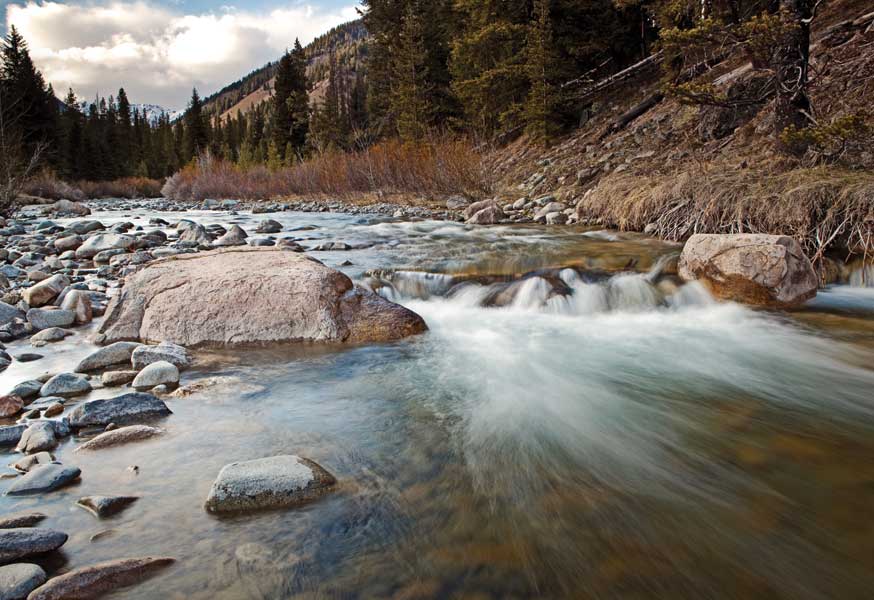Born at the Headwaters
The Big Wood River is a place wild rainbow trout are born, live and die, inspiring generations of anglers.
By Jason D.B. Kauffman
Photos by Jason D.B. Kauffman &
Elizabeth Belts Kauffman
With a well-timed swish of her powerful tail, the female rainbow trout maneuvers into place. Sleek and 15 inches long, she’s discovered her spot in the clear, cold waters. Alongside her, a large male rainbow keeps pace.
It’s early May. Dripping snowbanks still crowd the shores along the upper North Fork of the Big Wood River where the pair swims.
Sweeping her tail vigorously in a peculiar sideways motion, the female scours a depression in the red, brown and yellow cobble. Into this, she releases 2,000 bright pink eggs. Bobbing and weaving on the same currents, the male releases a steady stream of milt to fertilize the eggs.
With another series of sweeps above the hole she’s dug—called a redd—the female covers the fertilized eggs with cobble.
The adult rainbows don’t remain long. Better feeding opportunities, deeper holes and safer cover from predators are calling. Riding along on the high spring flows, they return to their normal haunts in the Gimlet stretch of the Big Wood River, just south of Ketchum. They may or may not live to spawn another spring.
Back up at the headwaters of the North Fork, an amazing life journey has just begun.
No other fish has so completely haunted the dreams of so many anglers as that ruler of dancing streams and churning rivers, the rainbow trout. Generations of American anglers have elevated the brightly hued Oncorhynchus mykiss to the pinnacle of a rough hierarchy of freshwater fish species, observes Anders Halverson in his book An Entirely Synthetic Fish.
One can hardly blame the angler who equates the nobility of the rainbow with the jagged summits, tall trees, deep gorges and big skies that embrace its clear-water birthplaces. “He is the aristocratic buccaneer of big waters,” Halverson writes. “His heritage is the deep, boiling rifts, swift currents and dancing whirlpools.”
He may as well be describing the Big Wood River. And perhaps he is. Halverson spent a portion of the 1990s writing for Ketchum’s Idaho Mountain Express newspaper. One cannot live and work alongside a river as lovely and trout-filled as the Big Wood for long and have it fail to seep into his very being.
Many an angler has devoted his or her life to chasing the darting shapes of rainbows among gin-clear streams and rivers. Rainbows aren’t the most challenging to net—the cagey brown trout of European descent makes a convincing argument for that title. Nor are rainbows the easiest to tempt—that trait is generally awarded to cutthroat and brook trout, who inhabit remote streams where lighter angling pressure translates into less-wary fish. But the rainbows are the perfect quarry for the dedicated fisher of freestone rivers and streams. According to Halverson, "Angling for rainbows in the vertical tumult of racing water is trout fishing raised to its supreme eminence."
Even at the hidden headwaters of the North Fork, life isn’t easy for the newborn rainbow trout. Not all the eggs were fertilized, and there’s no guarantee that those that were will survive beyond a few days. Most do not. But for a few, a mixture of chance, lucky placement in a protected crevice between the rounded cobbles, and the fact that the stream contains very little choking sediment means survival.
Within 20 days, dark-colored eyes appear in the center of each of the eggs. Fisheries biologists call this the "eyed egg stage." Protected by the cobble, the eggs remain in this state for several weeks.
In one of those narrow crevices between the cobbles, one of the developing rainbows—a female—nudges out of her egg. She's a sack fry now, or alevin, a stage indicated by the pinkish egg yolk connected to her slender body. The yolk will continue to nourish the tiny, hiding trout for another week or two.
Hunger finally drives her out of the protective cobble. Immediately caught up in the swift, early-summer current, she's carried downstream with other surviving fry to deeper holes and larger water. Her egg yolk gone, a process biologists call "buttoning up," she's now a full-fledged fry.
Somewhere miles downstream, the fry-now barely three-quarters of an inch long-is swept into a peaceful eddy just upstream from Ketchum. Fortunately for her, she winds up near an overhanging shore, where a submerged tangle of roots provides cover. Many of her siblings are not so fortunate, as birds skim them off the surface of the water. Dark shapes that race by in the faster current-hungry brown trout-gobble up others.
By August of her first year, the young rainbow has grown to 4 inches. Finally able to swim in swift bursts, she makes short forays into the current in search of aquatic insects. She'll need all the nutrients she can get as summer turns to fall, the trees lose their leaves and the real challenges of winter close in.
Redband rainbow trout have swum the free-flowing rivers and creeks of present-day Idaho since well before recorded time. It's believed this ubiquitous fish (one recent survey found 1,329 rainbows 8 inches or longer for every mile of the Big Wood) arrived sometime after Shoshone Falls formed on the Snake River, in the aftermath of the earth-shaping Bonneville Flood some 15,000 to 60,000 years ago. The falls kept rainbows from invading farther into the upper Snake River, a stretch occupied by Yellowstone cutthroats.
Redband rainbows and steelhead trout are the same species; the only difference is steelhead migrate to the ocean as young smolts, whereas redbands remain in freshwater streams.
In contrast to other Idaho streams, where Yellowstone and westslope cutthroat flourish, the Big Wood is believed to have been the exclusive haunt of the redbands. That is until humans began to alter the nature of the ecosystem for the benefit of fishermen.
Her first winter is a cold and snowy one. As the frigid weather robs the Big Wood of incoming flows for months on end, the river drops to its lowest levels. Pushed from her hiding spot in the protected web of roots by the receding water, the 5-inch female trout is forced to swim in the same currents as larger predatory trout. Fortunately, slower metabolisms brought on by winter mean larger fish are feeding less.
By late April, the spring warm-up sends the river overflowing its banks. It's one of those rare, once-in-a-decade floods. Suddenly, the female rainbow has more places to swim and hide as the swollen river crests. Slower flows passing through the treed floodplains provide the rainbow with an escape from the raging river.
Months later, the female trout, now in her second summer, begins to feed on the insect hatches that have made the Big Wood famous. All the fish in the river-rainbows, introduced brown and brook trout, and native mountain whitefish, a species that’s often overlooked-gorge on the bounty. By fall of her second year, the female rainbow is 8 inches long.
Two years pass, and still she survives, feeds and grows. One summer day, spying a fat fly as it hits the dappled surface of the water, she darts after the nutritious insect and scoops it up.
It's a mistake, but one she'll survive. The angler delicately removes the artificial dry fly from her mouth and releases her into the current. She's joined nearly a third of her wild counterparts estimated by biologists to have been caught and released by anglers on the Big Wood River.
By the autumn of her third year, the rainbow is an impressive 12 inches and full of vigor. She doesn’t sense it yet, but profound changes are in store next spring.
Wild rainbow trout face a hazardous existence. Threats to their well-being come from both above and below.
But the more insidious threat facing all trout today are introduced fish. On the Big Wood, as in other regional rivers and streams, non-native brown and brook trout now swim alongside native inhabitants. These outsiders compete for the river’s limited space and food.
A related threat to wild rainbows is perhaps the most bizarre of all: other rainbows. Or more specifically, hatchery-reared rainbows with a genetic pedigree more complicated than a mixed-breed pooch at the animal shelter.
For more than a century, hatchery managers across the West—including here at the Hayspur Fish Hatchery near Picabo—have crossbred rainbow brood stock with different strains scooped from rivers and streams far and wide. They selected rainbows for traits such as the flashiest coloring, best fighting ability and greatest growth potential. Transplanting these hybrids into rivers helped sustain the rising class of anglers who wish to fill their wicker creels with the night's dinner. Wild stocks simply could not—and still cannot—sustain the pressure of anglers who keep their catch.
Thrown into rivers like the Big Wood by the thousands, these mixed-heritage rainbows began to interbreed with native redbands. The result was an across-the-board decline in genetic diversity, resulting in a breed of fish less prepared to survive the rigors of a wild stream life. Other species of native trout on other rivers have not been immune, either.
The result: In today's human-modified world, few fish deserve the "native" moniker. Most are simply called "wild."
Today, thanks to the marvels of artificial propagation, the rainbow-truly native only to the Pacific Rim, which stretches from Mexico, through the Pacific Northwest and Alaska, and on to Russia's Kamchatka Peninsula-exists in streams, rivers and lakes on every continent except Antarctica. In the U.S., hatchery operations ensured the expansion of their range from sea to shining sea.
Fortunately for the wild rainbows of the Big Wood, which still have some redband genetics running through them, changing policies have slowed or perhaps even halted this slide toward hybridization. In 2000, the Department of Fish and Game began emphasizing the preservation of wild fish in Idaho. Today's hatcheries only produce sterile rainbows for transplanting.
In more and more places where rainbows weren't native inhabitants, wildlife agencies have begun authorizing the removal of introduced populations of Oncorhynchus mykiss. This summer, anglers are being encouraged to keep any rainbow they catch on the South Fork of the Snake River in eastern Idaho, whose native trout is the Yellowstone cutthroat.
The death knell hasn't been sounded for hatchery fish, however. The preliminary results of a five-year study that concluded last year suggest that when modern transplant procedures are followed and streams are not overloaded with artificially reared fish, hatchery operations have no measurable impact on wild fish.
That's good news for the segment of the sporting public with whom hatchery put-and-take programs are very popular. If the results of the study are born out—something fisheries managers across the West will be waiting to see—it means wild and hatchery fish may be able to coexist.
Today, hatchery rainbows are introduced in the Big Wood only above Ketchum and on tributary streams like Warm Springs Creek and Trail Creek. That protects stretches below Ketchum and Hailey, managed for wild trout, from being overrun with small hatchery rainbows, which would certainly upset the valley's catch-and-release, wild-trout purists.
"They would find it offensive to find 8- to 10-inch (hatchery) fish on the end of their lines," said Doug Megargle, Fish and Game's Magic Valley regional fisheries manager.
It's early April. Passing snow squalls speckle the surface of the upper Big Wood. A third winter has passed. The female rainbow, now more than 13 inches long, feels an urge she’s never felt before. Something pulls her upstream.
As she swims upriver mile after mile, the healthy rainbow trout smells something familiar. It’s the individual chemical makeup of the stream in which she was born.
Following her natural homing instincts, the rainbow fights against the North Fork's strong current, finally arriving in the same pool-and-riffle stretch of her birth. Like her mother, she pairs up with a male rainbow. Brief parental duties completed, they ride the high spring flows back downstream.
Many rainbows in the Big Wood live up to seven years and make multiple spawning runs. In her case, two more spawning seasons will pass before the female rainbow trout-finally spent by the rigors of her wild stream life-perishes.
Up at the wild headwaters of the North Fork, the next generation of rainbow fry soon wiggle out of the red, brown and yellow cobbles.
|





